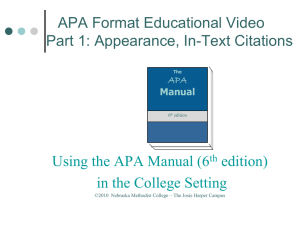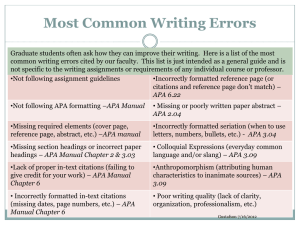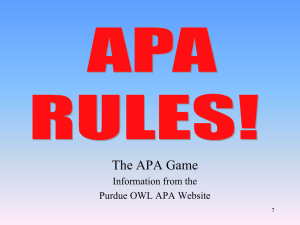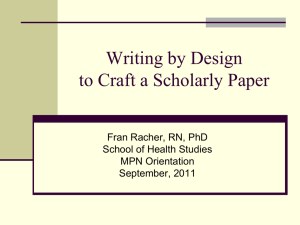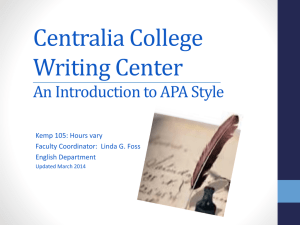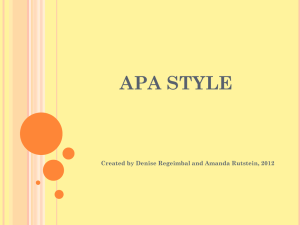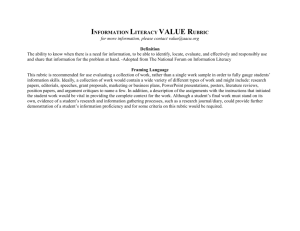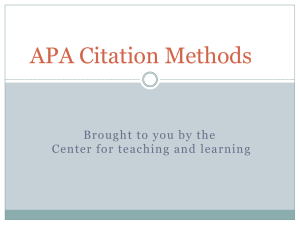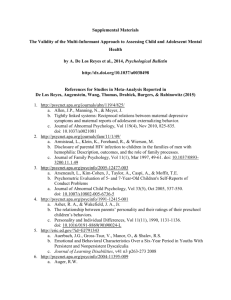APA Style and Format
advertisement
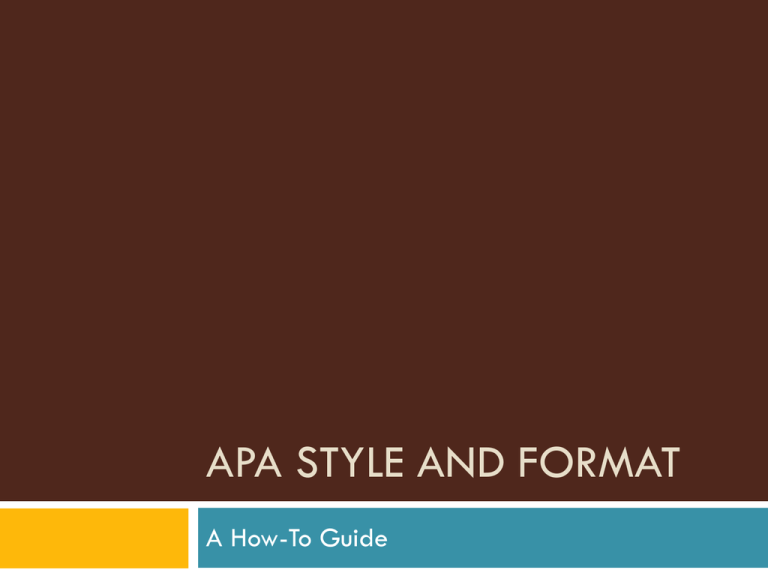
APA STYLE AND FORMAT A How-To Guide General Format Your essay should: be typed, double-spaced, with two spaces after punctuation between sentences on standard-sized paper (8.5”x11”) with 1” margins on all sides in 10-12 pt. Times New Roman or a similar font include a page header (title) in the upper lefthand of every page and a page number in the upper right-hand side of every page General Format (cont’d) Your essay should include four major sections: References Main Body Abstract Title page Note: Some Professors don’t require the abstract. Title Page Page header: (use Insert Page Header) title flush left + page number flush right. Title: (in the upper half of the page, centered) name (no title or degree) + affiliation (university, etc.) What should my title look like? APA style titles State the main idea concisely Identify essential variables or theoretical issues of import School Counselors’ Role in Dating Violence Intervention Evidence-based Counseling Interventions with Children of Divorce: Implications for Elementary School Counselors Bottom line: Be accurate; Be concise (and you can shorten it for the “running head”) Abstract Page Page header: do NOT include “Running head:” Abstract (centered, at the top of the page) Write a brief (between 150 and 250 words) summary of your paper in an accurate, concise, and specific manner. Should contain: at research topic, research questions, participants, methods, results, data analysis, and conclusions. May also include possible implications of your research and future work you see connected with your findings. May also include keywords. Main Body (Text) Be sure the first text page is page # 3 (or 2, if no abstract) Type the title of the paper centered, at the top of the page Type the text double-spaced with all sections following each other without a break Identify the sources you use in the paper in parenthetical in-text citations Format tables and figures What goes in the main body? Introduction Review of the Literature Analytical compilation of relevant research Implications Topic and purpose Answer “Who cares?” and “So what?” Conclusion The big “take-away” for the reader References Page Center the title– References—at the top of the page Double-space reference entries Do NOT include “Running head:” in the header after the title page! Flush left the first line of the entry and indent subsequent lines (“hanging indent”) Order entries alphabetically by the author’s surnames References: Basics Invert authors’ names (last name first followed by initials). Alphabetize reference list entries by the last name of the first author of each work. Capitalize only the first letter of the first word of an article title and subtitle, the first word after a colon or a dash in the title, and proper nouns. Do not capitalize the first letter of the second word in a hyphenated compound word. References: Basics (cont’d) Capitalize all major words in journal titles. Italicize titles of longer works such as books and journals. Do not italicize, underline, or put quotes around the titles of shorter works such as journal articles or essays in edited collections. List of References Check and follow all rules regarding multiple authors Check and follow rules of capitalization and notation of titles Check and follow rules in general! References Basics: Books and Book Chapters Helfer, M. E., Kempe, R. S., & Krugman, R. D. (1997). The battered child (5th ed.). Chicago, IL: University of Chicago Press. O'Neil, J. M., & Egan, J. (1992). Men's and women's gender role journeys: A metaphor for healing, transition, and transformation. In B. R. Wainrib (Ed.), Gender issues across the life cycle (pp. 107-123). New York, NY: Springer. References: Periodicals (print & “e”) Scruton, R. (1996). The eclipse of listening. The New Criterion, 15(30), 5-13. Bower, H. (2001). The gender identity disorder in the DSM-IV classification: A critical evaluation. Australian and New Zealand Journal of Psychiatry, 35, 1-8. doi:10.1046/j.1440-1614 .2001.00859.x What is a DOI??? Digital Object Identifier: Provides universal identifying information for a piece of writing Must be included in every article reference Bower, H. (2001). The gender identity disorder in the DSM-IV classification: A critical evaluation. Australian and New Zealand Journal of Psychiatry, 35, 1-8. doi:10.1046/j.1440-1614 .2001.00859.x Digital Object Identifier: Location Digital Object Identifier: Location What if I don’t have a DOI? Use the homepage web link Meyer, W., III, Bockting, W. O., Cohen-Kettenis, P., Coleman, E., DiCeglie, D., Devor, H.,..Wheeler, C. C. (2001). The Harry Benjamin International Gender Dysphoria Association's standards of care for gender identity disorders. International Journal of Transgenderism, 5(1). Retrieved from http://wwwsymposium.com/ijt/soc_01/index.htm Integrating Sources: Paraphrasing v. Quoting Quoting=precise wording Paraphrasing=restating: intentionally NOT precise wording OR sentence structure APA suggests more paraphrasing than quoting Integrating Sources: Logic Using Signal Phrases Marks boundaries Maintains fluency and authority Most teachers gain experience on the job and develop rigid habits and theories after as few as four years. “Many teachers don’t last that long” (Kidder, 1989, p. 51). Kidder (1989) asserted that most teachers gain experience on the job and develop rigid habits and theories after as few as four years, but he cautions that “many teachers don’t last that long” (p. 51). Integrating Sources: Logic Contextualizing Introduces material smoothly Provides opportunities to analyze The solutions proposed by a number of advocacy groups underscore this interest in political and cultural change. A report by the Henry J. Kaiser Family Foundation (2004) outlined trends that may have contributed to the childhood obesity crisis, including food advertising for children as well as “a reduction in physical education classes…, an increase in the availability of sodas and snacks in public schools…, and the increasing number of highly processed high-calorie and high-fat grocery products” (p. 1). Addressing each of these areas requires more than a doctor armed with a prescription pad; it requires a broad mobilization not just of doctors and concerned parents but of educators, food industry executives, advertisers, and media representatives. Integrating Sources: Fluency …Ellipses… [Brackets] P,u.n:c;t,u.a:t;i.o,n! Ellipses Take the place of omitted words What remains MUST be grammatically complete! Roman (2003) reported that “social factors are nearly as significant as individual metabolism in the formation of…dietary habits of adolescents” (p. 345). Brackets Help explain confusing references Help create proper grammar in context Jan Harold Brunvand (2009), in an essay on urban legends, states: "some individuals [who retell urban legends] make a point of learning every rumor or tale" (p. 78). Jan Harold Brunvand claims some re-tellers become obsessed, “mak[ing] a point of learning every rumor or tale” (p. 78). Punctuation Maintain it within the quotation, OR use brackets or ellipses to modify Drop it at the end of the quoted portion, and continue punctuating YOUR sentence after the parenthetical citation. Robbins et al. (2003) suggested that the “therapists in dropout cases may have inadvertently validated parental negativity about the adolescent without adequately responding to the adolescent’s needs or concerns” (p.541), contributing to an overall climate of negativity. Exceptions: ? and ! Ex: “…contributing factors?” (p.9), a valid question in light of… In-Text Citations Whether you paraphrase or quote, you MUST cite! Citations are uniform in either case (paraphrasing or quoting), but differ by context Two types of citations Contextual – generally, author’s surname and year within the body of the sentence According to Mitchell and Jansen (2004), bullying leads to detrimental attitudes and experiences (p. 34). Parenthetical – author’s surname and year appear in parentheses, usually at end of sentence …negative effects of bullying” (Mitchell & Jansen, 2004, p. 34). …bullying leads to detrimental attitudes and experiences (Mitchell & Janson, 2004, p. 34). Exception: Long quotations More than 40 words Indented five spaces on the left throughout NO quotation marks! Citation as follows… Sample Long Quotation The solutions proposed by a number of advocacy groups underscore this interest in political and cultural change. A report by the Henry J. Kaiser Family Foundation (2004) outlined trends that may have contributed to the childhood obesity crisis, including food advertising for children as well as a reduction in physical education classes and after-school athletic programs, an increase in the availability of sodas and snacks in public schools, the growth in the number of fast-food outlets . . . , and the increasing number of highly processed high-calorie and high-fat grocery products. (p. 1) Addressing each of these areas requires more than a doctor armed with a prescription pad; it requires a broad mobilization not just of doctors and concerned parents but of educators, food industry executives, advertisers, and media representatives. Notice the difference in parenthetical placement! APA Writing Style Present your ideas in an orderly fashion. Use transitions (then, next, while, since) Addition links (in addition, moreover, furthermore, similarly) Contrast links (but, conversely, however, although) Cause-effect links (therefore, consequently, as a result) APA Writing Style Use consistent verb tenses Use the past tense to describe results Use the present tense to discuss results and present conclusions Say only what needs to be said Eliminate redundancy, wordiness, jargon, overuse of the passive voice, clumsy prose APA Writing Style Aim for precision and clarity Choose your words carefully. Make certain each word choice means exactly what you intend it to mean. Eliminate colloquial expressions such as “quite a large part,” “practically all,” and “very few.” Clarify pronouns or avoid using them if possible. Avoid the first person, including the ambiguous “we.” APA Writing Style Word Choice Avoid labels when possible (not “the mentally ill,” but “people with mental illnesses”) Be wary of the verb “prove”—instead, “studies indicate” or “evidence suggests” More on Writing Style Chapter 3 in the APA Manual(6th ed.): “Writing Clearly and Concisely” Well worth the read! The Little Things… In your own text, use “and” when there are two or more authors. Within citations, use “&.” Sartes and Neinstein (2002) note that adolescent girls are more likely to experience symptoms of depression that adolescent boys. Adolescent girls are more likely to experience symptoms of depression than adolescent boys (Sartes & Neinstein, 2002). The Little Things… When citing information from multiple sources, list the sources in alphabetical order and separate with semi-colons. Recent studies (Howard, Stein & Frazer, 2004; Lance & Armstrong, 2004; Shine, 2003) indicate that at least one tenth of working women have been harassed within the past year. The Little Things… When citing a secondary source, use the following format: Women are reluctant to report harassment out of fear of retaliation (Howard & Glasser as cited in Jones, 2003). Note: Only the “Jones” citation will appear on the references page. Note: It is considered much stronger in terms of research technique to find and use the original source! The Little Things… Sources without dates Use the abbreviation “n.d.” for no date. Only one study suggests that students are motivated solely by internal values (Smith, n.d.). Helpful Links! www.apastyle.org (check out the FAQs) http://owl.english.purdue.edu/ (sometimes quicker than using the manual—also, great writing resources in general) http://ww2.sjc.edu/pdf/cae/signalphrases.pdf http://ww2.sjc.edu/pdf/cae/transitionaldevices.pdf
